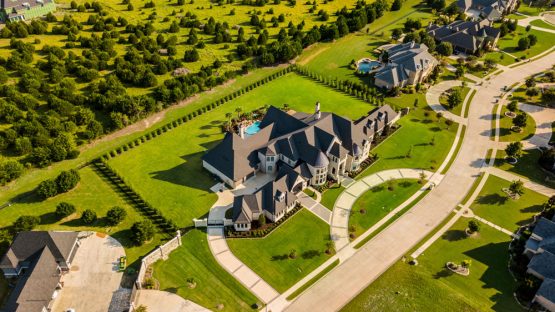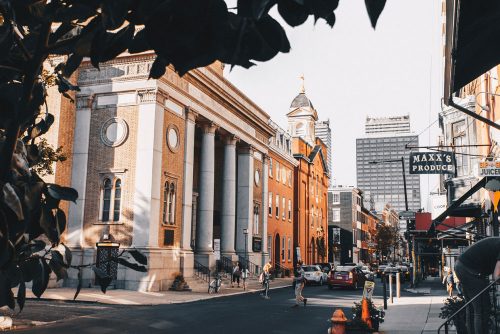
After reviewing my analysis on a conversation I had with a financial professional in 2013, I decided to take another close look at my finances. To my surprise, I uncovered a huge gap between my perceived risk tolerance and the reality of my portfolio. Since leaving work in 2012, I’ve generally seen myself as a […]
The post Uncover Your True Investment Risk Profile: It’s Not What You Think appeared first on Financial Samurai.

Today, we’re continuing with our 4-part series on how to create content to promote your business. In this episode, we talk about what it takes build an engaging email list that converts to sales. What You’ll Learn How to keep your open rate high How to drive sales with every send How to keep your subscriber engaged with your list Sponsors SellersSummit.com – The Sellers Summit is the ecommerce conference that I’ve run for the past 8 years. It’s small and intimate and you’ll learn a ton! Click Here To Grab The Recordings. The Family First Entrepreneur – Purchase my […]
The post 563: Email Marketing Hacks To Drive Engagement and Sales appeared first on MyWifeQuitHerJob.com.

The Big Picture On Earning Infinite Returns Through Real Estate Investment:
-
- Infinite returns mean pulling out your initial investment to reinvest elsewhere while still earning on the property. Focus on properties you can renovate and refinance to start building equity fast.
- The BRRRR strategy (Buy, Rehab, Rent, Refinance, Repeat) is popular for achieving infinite returns in rental properties, but it requires careful planning, especially around managing refinancing costs and market fluctuations.
- Real estate syndications can offer infinite returns without day-to-day management but keep an eye on potential risks, like debt levels and market downturns, which can affect cash flow.
Disclaimer
The information provided on this website is for general informational purposes only and should not be construed as legal, financial, or investment advice.
Always consult a licensed real estate consultant and/or financial advisor about your investment decisions.
Real estate investing involves risks; past performance does not indicate future results. We make no representations or warranties about the accuracy or reliability of the information provided.
Our articles may have affiliate links. If you click on an affiliate link, the affiliate may compensate our website at no cost to you. You can view our Privacy Policy here for more information.
If you earn $1 on a $0 investment, what’s the rate of return?
What about $100? $1,000?
The answer’s the same: any return on a $0 investment is an “infinite return” since you’re dividing it into zero. You earn something on an investment of nothing.
But how does that actually work in the real world? Doesn’t it “take money to make money” and all that?
Sort of.
What Are Infinite Returns?
When you invest money in real estate — or anything else, for that matter — you ideally earn a return on it. However, real estate has a unique advantage over other assets: you can borrow money against it relatively cheaply at a high loan-to-value ratio (LTV).
Even better, you can force appreciation through property improvements. That combination means you can buy a fixer-upper, renovate it to boost its value and create equity, and then refinance it to cash out that newfound equity. And in doing so, pull your original down payment back out of the property, potentially leaving you with $0 of your own cash invested in it.
Every dollar you earn in returns from that point onward represents an infinite return on your $0 investment in the property.
You can earn infinite returns on direct property investments or through real estate syndications.
Strategies for Generating Real Estate Returns Without Capital at Risk
Strategic positioning is the secret to achieving returns without having your capital tied up long-term. Sounds simple, right? Yep, but it’s not as easy.
| Strategy Type | Key Requirements | Main Benefits |
| Forced Appreciation | Construction or renovation expertise; Good contractor network | Property value increases under your control |
| Buy and Hold with Refinance | Strong credit score; Stable rental market | Long-term wealth building; Tax advantages |
| Partner Syndication | Lower minimum investment; Professional network | Passive income; Shared risk |
| Cash Out Refinance | Equity buildup; Good debt-to-income ratio | Access to capital while retaining ownership |
| Value-Add Commercial | Market analysis skills; Property management experience | Higher potential returns; Scale advantages |
| Live-in Flip | DIY skills; Flexible living situation | Tax-free gains on primary residence |
| Joint Ventures | Strong negotiation skills; Legal documentation | Shared resources; Expanded opportunities |
Infinite Returns on Rental Properties: The BRRRR Method
The strategy of buying rental properties directly and renovating them is called the BRRRR method.
The acronym BRRRR stands for buy, renovate, rent, refinance, repeat. It works particularly well with 1-4 unit residential properties, but you can also do it with 5+ unit apartment buildings. For residential properties with up to four units, you can refinance with a conventional mortgage or a portfolio loan, typically up to 80% LTV but possibly up to 85%.
It works because the refinance loan amount is based on the property’s after-repair value (ARV), not what you paid for it. You create equity by renovating the property and then cashing out that equity. Try Credible to compare conventional mortgages or Kiavi or Forman Loans for portfolio loans.
Once you pull your money out of the property, it frees you to reinvest it in another property. You can use the same down payment repeatedly to build your real estate portfolio.
Remember that the more you leverage your properties, the lower your cash flow will be. Avoid taking on so much debt that you lose money on your properties each month.
Infinite Returns on Real Estate Syndications
The same model works with apartment complexes, just on a larger scale.
A syndicator or sponsor finds a property that needs updating, which they call a value-added deal. They take out a loan to cover some of the purchase price, and they cover the rest of the costs with their cash and by raising money from private investors (called limited partners or LPs). As an LP, you invest passively in the project and become a fractional owner.
The sponsor spends the next year or two renovating the exterior, common areas, and interior of each unit. This drives up the market rent for each unit, so the net operating income rises. That, in turn, drives up the value of the property since income properties like apartment buildings are priced based on the income they generate.
Once all renovations are completed and the rents are stabilized at new higher prices, the sponsor can refinance the property based on the new higher value. They pay back the passive investors’ capital, but all investors retain their ownership share in the property.
Again, the cash flow will drop based on the new higher debt. However, investors keep collecting cash flow on the property, even though they have already received their initial investment back. As with the BRRRR strategy, you can reinvest that money in more properties or syndications, snowballing your passive income from real estate.
Risks & Challenges with Infinite Returns
Earn real estate cash flow without having my money tied up in properties? What’s the catch?
While there’s no catch per se, there are risks and challenges. The first of those I touched on above is that more debt means less cash flow per property. If you leverage your properties too much, you run the risk of negative cash flow.
You need far more properties for direct property investments to create the same net rental income. That means more labor: finding deals on properties, hiring and overseeing property managers, accounting, etc. The labor gets even more intense if you self-manage your properties.
Some investors rapidly expand their portfolio with the BRRRR method, letting the properties appreciate and generate more cash flow over time as rents increase. Eventually, they sell some of their portfolio to pay off the loans on their remaining properties. That eventually leaves them with fewer properties that cash flow well and require less labor to oversee.
On the syndication side, you don’t have to worry about labor in managing more properties. But you need to find new investments to redeploy your capital as you get it back after refinances. Still, finding good passive investments is far easier than finding good deals on properties to buy directly.
Finally, you do need money to invest in the first place. That initial down payment for a rental property could still cost you $50,000 or more, which says nothing of closing costs or the money you need to put up for the renovation. Sure, most purchase-rehab loans for investment properties reimburse you for renovations, but you still need to pay for each draw before the lender reimburses you. Syndications also require $50-100K as a minimum investment unless you pool funds for group real estate investments (like we do in our Co-Investing Club).
(article continues below)
How Realistic Are Infinite Returns?
Infinite returns are an incredibly powerful way to build income streams from real estate. You can reinvest the same $50,000 in property after property, syndication after syndication. Each one adds another passive income stream without you having to keep coming out of pocket to invest.
But as powerful as the concept is, it rarely works out in the real world the same way it works on paper. In most cases, you can’t pull out every single dollar you invested in an investment property or syndication. You often get back 50-80% of your initial investment, but not all of it.
That means you rarely earn true “infinite returns” on your investment. Instead, you earn high “cash on remaining equity” or cash on equity, but it’s not infinite since you still have more than $0 invested in the property.
For example, imagine you invest $5,000 in syndication as a member of our Co-Investing Club. After two years, the sponsor refinances the property and returns $4,000 to you. Up to that point, you had earned a 5% cash-on-cash return ($250/year on your $5,000 investment). After the refinance, you still earn $150/year on your remaining $1,000 tied up in the property: a 15% return on your remaining equity investment. Over the next five years, the cash flow gets even better as rents rise, and by the end, you’re earning 20% each year. Then, the sponsor sells the property, and you collect a hefty payout for your ownership interest.
In the meantime, you could reinvest that $4,000 in another deal and earn cash flow from that. You start rolling the snowball down the mountain, adding new sources of income with each new deal you invest in.
Tax Implications and Benefits
One factor that makes infinite returns even more interesting is that the tax benefits are just as impressive as the returns. We’ve talked about pulling your initial investment back through refinancing, right? The IRS doesn’t consider that money as income – it’s viewed as debt. That means you’re getting your investment back without paying a dime in taxes.
Think about the BRRRR strategy. Each time you complete a cycle – buying a property, renovating it, renting it out, and refinancing – you’re not just building wealth. You’re also creating multiple streams of tax advantages. What about property improvements you make? Those renovation costs are either deductible or can be depreciated over time. The interest on your new, larger loan after refinancing? That’s deductible against your rental income too.
Even better, while your tenants are paying your loans and earning essentially infinite returns, you can depreciate the property. This paper loss often offsets your rental income, meaning you might show minimal taxable income while your cash flow remains strong. It’s not a bad deal when you use mostly the bank’s money to build your portfolio.
For syndication investors, the tax benefits work similarly on a larger scale. When that apartment complex gets refinanced and returns your initial investment, that’s not a taxable event. Meanwhile, you get your share of depreciation and other deductions, even as a passive investor.
However, here’s the real power play. As your properties appreciate and you build more equity through tenant-paid mortgage pay down, you can keep doing cash-out refinances to pull out more tax-free money to reinvest. Think about a tax-advantaged ATM that keeps giving while your properties earn returns. This is the closest thing to it.
Final Thoughts on Infinite Returns
Whether you can pull every dollar back out of a property is beside the point. You can still pull a lot of your initial investment back out while keeping your ownership of each property. That lets you keep reinvesting and growing your portfolio, adding new passive income streams, and adding properties that each appreciate over time.
In other words, you build a portfolio of assets with mostly other people’s money. You get all the investment property tax deductions, the cash flow, and the appreciation, while lenders provide most of the capital. And then your renters pay down the loans for you.
Not a bad investment strategy, eh?
Have you ever earned infinite returns on an investment property? What challenges are you encountering in pursuing infinite returns?
More Real Estate Investing Reads:
I want to know more about…
The post How to Earn “Infinite Returns” on Real Estate Investments appeared first on SparkRental.

This year, I simplified the two monthly articles that I’ve done for years – passive income and goals/resolutions. I’ve combined them and added some personal details.
Personal Monthly Recap
- The month started with my wife deployed for Hurricane Helene.
- We went to a local Harvest Festival and entered my cousin’s zucchini, which won first place. Our kids did some tug of war and sack races – lots of old-fashioned fun.
- We had a special trip to the zoo with the Cub Scouts that had behind-the-scenes animal interactions. The zoo was doing its annual pumpkin festival with around 5,000 lighted carved pumpkins that they replace every week (as the pumpkins go bad). It’s outsourced to a company called Passions for Pumpkins which does it for three states in the US
- My wife and I ran over the Pell Bridge – the longest suspension bridge in New England. It was great to watch the sunrise. Fortunately, it wasn’t as cold as last year.
- We went to Atlanta for FinCon. The kids crammed a lot into a few days, including Coca-Cola World and the largest aquarium in the United States.
- We celebrated Halloween with some friends, and the kids got enormous amounts of candy.
- We did the local annual corn maze. It’s always fun to get lost in nature for an hour or two.
[One of the thousands of carved pumpkins – an iconic moment in New England sports history.]
Back to the Passive Income and Goals
I put my goals in a spreadsheet and review it once a month. I know that I have too many goals to complete them all. That gives me the freedom to work on a few different things. Most people focus on fewer goals and aim to complete them. They find it much less overwhelming. That’s just another reason why I’m weird. Do whatever works for you.
Click for a larger version in a new window
I just realized now that all year I’ve had Hobbes in my spreadsheet. He’s a great comic character, but I meant Hobbies.
Passive Income
I have three side hustles with a passive component: a dog-sitting business, this blog, and managing a website for a non-profit. All three require some active work. However, I can get paid for all three even while working a full-time job. That’s why I consider them somewhat passive income.
If this definition of passive income seems off or confusing, please refer to my the last stand-alone article on passive income.
Dog, Blog, and Web Income
Dog boarding was fairly average in October. I could have done better, but I went to the annual financial creator conference, FinCon. Not being around for a weekend meant that I couldn’t take dogs.
[Our puppy had a play date with her biological sister. They both came up to Rhode Island from Atlanta.]
Blogging income continues to be terrible. Much of my income comes from people finding the site on Google and seeing the ads. Google is sending a lot less traffic nowadays. They’ve focused on showing results from big brands and shopping results. Of course, with AI results, much of the time, people don’t even need to click on a website. I’m going to switch some things up, so stay tuned for that over the next few months.
The non-profit website I manage doesn’t pay much, but I love being part of the organization. I hoped to add more this year, but so far, I haven’t come up with anything. I’m doing more work than I thought I would for the non-profit, and it looks like they have some surplus income. I’ve been trying to hint that the budget could go to technology, but it’s hard because I originally volunteered myself. Next year, I’ll have to take this out of the passive-ish income. They pay me every month, but I work enough that it doesn’t fit even my stretched definition.
Finally, I started doing some web work for a restaurant. That’s an hourly rate now, so I’m not including it here. Hopefully, it will translate to some kind of retainer, which I might include here.
October’s dog, blog, and website income was $3,888.72. The previous month, it was $5,369.47.
Because this type of income requires some active work, I only count half of it as passive income. More on that later.
Rental Property Income
We have two rental properties. They still have 15-year mortgages, so the rental income is just a couple hundred dollars more than breaking even each month. We’re almost done with the mortgages, though, and they’ll make much more money (around $25,000 a year).
For the purpose of this report, I calculate their income using the following formula:
(Rents After Estimated Expenses) * (Equity Percentage Owned) = Passive Income
Estimated expenses are insurance, property taxes, condo fees, and estimated condo maintenance. Equity Percentage Owned (EPO) is our total equity divided by the property value in Zillow. (Zillow is very accurate for our condos.)
Zillow says our properties were worth $5,000 more than last month. That breaks a string of drops. We pay off about a thousand dollars of mortgage debt on them every month. That’s a recipe for gaining $6,000 in equity.
I calculate the rents on the properties at around $2,657/mo., after expenses. This calculation is a little disingenuous because I average what our true rents are and what the market says they should be. We should be charging a lot more, but we have good tenants, and we’re trying to be kind, considering the exploding housing costs.
This month, we owned 81.90% of the properties. Using the equation above, this would be $2,176 in monthly income. For a year, using this method, we’d net $26,113.
Last month, and the month before, it was $2,168, so we gained $8. That’s typically how this growth goes. It’s slow, but real estate has been one of my most consistently growing income streams.
[While my wife was away the kids built a LEGO Star Wars Millennium Falcon that I found on sale for under $100. They chipped in some of their money. Here, my son takes a break to read a book. (This is not the norm at our house.)]
Managing rental properties requires some work – a few days a year. For this reason, I only count 80% of this number as passive income.
Dividend Income
My wife has been maxing out her retirement accounts for a little more than two decades. I maxed out my retirement accounts for my first ten years of employment, but it got much tougher when I became self-employed. At that point, I mostly focused on maxing out my Roth IRA and a little on my SEP-IRA. Investing this money for so long has created quite the nest egg for us.
For the dividend income portion of our passive income, I assume we invested all the money in brokerage accounts (retirement and non-retirement) into an ETF that conservatively pays a 2.5% dividend. I use this 2.5% number because I’m too “Lazy” to track the exact dividends from all accounts. Also, dividend payments are very inconsistent, with most payments coming quarterly. Is 2.5% a fair number as an estimate? I’ll let you be the judge, but one ETF, iShares Core High Dividend (HDV), is paying around 3.63% right now.
I also have profit-sharing income with a private company in which I own a small stake. I get a check each month that behaves like a dividend – it’s just taxed a little differently.
[Ice cream and a science lesson at Sub Zero Ice Cream in Atlanta]
This month our dividend income using this estimation was $5,001. We finally broke the $5,000 mark! I grabbed these numbers on the night of the election, before the big run up the next day. Waiting would have made a significant difference, but I always try to grab the numbers on the 5th of the following month. Last month, September, this was $4,985 so you can see it’s a decent $16 gain..
Unlike the previous two sections, this income is 100% passive. For this reason, I don’t have to adjust the numbers.
Total Passive Income
Dog/Blogs: $3,888.72 – Adjusted to $1,944.36
Rentals: $2,176.00 – Adjusted to $1,740.80
Dividends: $5,001 – Remains at $5,001
Dogs/Blogs Blue Line
Rental – Red Line
Dividend – Yellow Line
Total Adjusted Passive Income: $8,686.16
That monthly income would be about $104,000 a year. I consider that financial indepence. We might be spending a little more than that as we make some home improvements and send our kids to fancy private school. We don’t need to spend as much as we do though.
Here’s a graph of the numbers since 2017, when I started keeping track:
(The blue line represents the monthly total adjusted passive income. The Red Line represents the 12-month average. This helps remove some of the seasonality of dog boarding.
Our 12-month average is $8,505.32. That’s a sliver below our all time high of $8,581.87 last August. I didn’t expect to make new highs this year and we’re running out of updates, but it’s possible. This is the core number that I want to beat because it shows that blogging doesn’t have to make any money at all to still do well. (I would still need the dog boarding to grow this number though.)
My wife continues to work as well. She now has 25 years in the military and will be getting a pension that effectively doubles all this passive income. Her job has gotten easier and seemingly more fun, so she might stay 30 years and grow the pension more.
I can’t think of anywhere else to put this information, but our net worth grew a modest 0.28% last month. Overall, it’s up 13.51% for the year. Our liquid cash was very much the same as the month before. Some people track their spending to know where their money goes. I’m too lazy, so I just look at the liquid cash number.
Business and Other Money Goals
Personal Income ($85,000)
Two years ago, I made over $98,000 in side hustles. Last year, I made $88,000. I’ve recently cut back on dog boarding a bit, so I’m aiming for $85,000 this year.
Through October, I made $68,998, which is on pace for $82,448.52. I think I’m going to fall short on this one.
Complete Estate Planning
After several months of not getting together with my wife to answer the lawyer’s questions, we finally were able to get it done. I had expected this to be easy, but it really is difficult.
[We were able to catch the Northern Lights. I loved how the moon was peaking out of the clouds at our local beach]
Kid Wealth (Goal: 50,000 Page Views)
For the third year, I hope to get 50,000 page views on Kid Wealth.
In 2022, I launched Kid Wealth and wrote a lot of articles. It had 4,200 page views that year. In 2023, I got involved in other projects, but traffic tripled to 13,708. This year, I’ve only posted a couple of articles – ouch.
For some reason, traffic surged in October after an already good September. I’m getting double the traffic that I was for most of the year. I have no ads and almost no way of making money. I’ve got some renewed interest in this and also some ideas for 2025.
Professional Improvements
A few months ago, I worked on my website to show off my freelance skills. This past month, I updated my LinkedIn for the first time in about 15 years. That was a major goal for this. Additionally, I got the web work for the restaurant that I mentioned above.
[This praying mantis was outside our garage. The prayers apparently did not help.]
Health
I’m putting more focus on health this year. As you can tell from the above, our financial situation is great. Now, we just have to be healthy enough to enjoy a few decades of spending our money.
Lose Weight and Body Fat (Goal: 175lbs, 22.5% body fat)
I started on January 1st at 192.5 pounds and 26.3% body fat, according to my Fitbit scale. Ouch!
At the end of October, my average weight was 180.2 – effectively the same as last month. My body fat was 23.1% on average. The 4-mile Pell Bridge run with my wife seemed to lower my body fat for a couple of weeks. Towards the end of the month, I started eating a little more healthy again. We’ll see if it pays off in the next report.
[Pell Bridge Run!]
Health Points (Goal: 350)
This year, I’m tracking my health by giving myself a score at the end of the week for diet and exercise. The top score in each is five points.
When I give myself a five, I am saying that I generally had the reasonably best week possible. I can only have a couple of off meals a week and still get a five. The rest of the time, I have to eat with a purpose, such as half fruits and vegetables or half plant protein. If go out to restaurants and just eat whatever I want, then I’m only going to get one point.
For exercise, I’d have to put in a very solid effort every day to get a five. At the start of the year, I got mostly one point each week. The weather wasn’t very good, and I wasn’t motivated to exercise. Since spring, I’ve started walking more – often getting in 10,000 steps a day. I need to do higher cardio and weights, but this is a step in the right direction.
With 52 weeks, I can earn a maximum of 260 health points each for diet and exercise.
At the end of October I have 222 points. That’s a pace for 266 points. I’m going to miss my goal, but I know it’s helped me make much healthier decisions. Next year, I’ll shoot for 300 points.
Health Appointments
Medical appointments are a very important part of staying healthy. Here’s what I’ve done this year:
Dental – I had to do some deep cleaning this year. It was two separate appointments where they did one side and then the other. I had the regular cleanings and a couple of fillings replaced, including one in October.
ADHD – I finally got diagnosed with ADHD. Getting the standard testing with a specialist was impossible, with the scheduling being months in the future and their insurance policies changing at that time. Finally, I did an assessment at ADHD Online and paid out of pocket. I brought the results to my primary care physician, and she prescribed me a very low dosage of Adderall. It’s been very helpful.
Body Analysis – In February, I got a body analysis from DexaFit after watching “You Are What You Eat” on Netflix. They scanned my body completely for body fat. I also got a VO2 max test for cardio fitness and an RMR metabolic analysis. The results weren’t what I was looking for, but they will be a good baseline. I should get a follow-up, but I’ve been busy. I don’t know if I’ll get another one this year.
[Went to a town street fair where this crazy marching band was.]
Annual Physical – I had my annual physical a couple of months ago. She had recommended a colonoscopy in the past, but I wanted to wait until I got my ADHD sorted out. I thought a colonoscopy was a quick procedure that took maybe a couple of hours. I don’t know how to do a whole day cleanse and then manage the next day with my responsibilities of caring for dogs and kids. I think it makes sense to push this to 2025.
Finally, I’m on quest to regrow hair. July was my first month. I think it takes about 4-6 months to see results. I think this is going quite well. I’m probably going to update that article within the next month. You can judge for yourself with the before and after pictures.
Hobbies
I almost never get time to do a hobby. I have too many jobs and house/kid management going on. Below are just some of the things I’d like to do:
- Learn AI
My goal at the beginning of the year was to look into becoming a “prompt engineer.” AI was advancing so fast that I thought that “prompt engineering” might be dead. Regular readers saw that I used AI effectively in a few articles in the last few weeks. After FinCon, I realize that I couldn’t afford to do nothing on this, so I bought subscriptions to ChatGPT and Claude. I’ve been using them both for some research and projects over the last couple of weeks.
- Canva
My kids use Canva at school, and they are better than I am. However, I used it in September to make a “gift card” for dog boarding, and it was super easy.
- 3D Printing
Still no progress on using the 3D printer.
- Rubik’s Cube
Last year, my 10-year-old mastered the Rubik’s Cube. He can speed-cube it in less than 90 seconds on average.
I’ve got about 92% of the algorithm memorized. I’d say that 70% of it is in muscle memory – I don’t need to think. About half the time, I get lucky and don’t need the other 8% of the algorithm. I was able to solve it in 2 minute and 17 seconds on one of those lucky tries.
- WordPress Blog as a Journal?
I should be keeping a journal of some kind. Lazy Man and Money is my money journal. The goal is a journal for everything else. I don’t think this is going to happen this year.
- Program in Python
I want to make a toy program to get my old software engineering skills going again. After seeing how the new ChatGPT can code, I wonder if this is even a useful goal.
Some of the new web work that I’m doing above has knocked the rust off. I’m giving myself partial credit for this one.
- Learn to fly a flight simulator
Let’s push this to 2025.
- Learn to play Backgammon
This may be a December thing to check a box off a box near the end of the year.
- Play a modern song on an ukulele
Another month with no progress on this one.
Overall, I’m doing much better with hobbies than I expected. I still have a couple of months left to make some more progress.
Family
Declutter and Organize House
Every year, we have some home improvement goals on the list. Last year, we got new carpets and interior paint.
This year, we are looking to declutter, organize, and upgrade the whole house. We hired a friend who is an interior designer and she put together a good plan. For years, we had a lot of cheap Ikea furniture. In May we finished the dining room, which is one of our smallest rooms.
In July, we cleaned out the office to make room for new desks. We also cleaned up the basement and made it much more functional. We now have a little workout area and an area for the kids to play. I set up some of my old gaming consoles and made them easy to play.
[Old school harvest festival!]
In August, we got the new desks and bookshelves. It’s fancy Pottern Barn – the stuff that lifestyle inflation is made of. Now, I just need to find the time to organize my existing stuff in that space.
In September, I got most of my stuff organized into that office space. I also did a little work on decluttering the garage. Our outdoor light fixtures were 30 years old and failing, so we replaced those. It sounds like a tiny baby step, but it required picking them out and scheduling an electrician. Finally, my wife has been listing and selling a lot of stuff on eBay.
Last month, we worked more on the office. My wife’s part is great. My side… needs work.
Our 10-year old said that we’re practically in a completely different house with every room getting upgrades. He simply volunteered this insight without me prompting him about the changes.
Travel
In March, we spent a week on a Yucatán Peninsula cruise on one of Royal Caribbean’s biggest cruise ships and another week at Disney World.
In April, we went to the eclipse and did a day of skiing. Usually, I wouldn’t count weekends as travel, but it was a notable life experience.
In June, we went on our annual trip to Block Island. We can drive to the ferry in a half hour and be on the island in 90 minutes. It’s a nice staycation for four days. The highlight was a scavenger hunt that we did on our phones. It was all virtual.
Of course, the big August trip was to see Paramore and Taylor Swift, go to Stonehenge, and do a Beatles tour in Liverpool.
In October, the whole family went to Atlanta. I had my FinCon conference, so the hotel room was already booked. My wife knows a lot of peope at the CDC and wanted to meet up with them. The kids came along to see the Coca Cola factory and the largest aquarium in the United States. It was a short trip, but still valuable.
[I didn’t see the sign that said we shouldn’t climb on the rings until it was too late. Whoops!]
I’ve taken a couple of days to put together some travel plans for 2025. Nothing is firm yet, but I feel good about the preliminary plans.
Kids
Kids are halfway through the first semester of school after a successful summer of camps. Their after-school activities are karate, First Lego League, and Scouting America. The 12-year-old will be in two school plays over the next few months while starting on the school swim team. Our 10-year-old is going to give basketball a shot. That will carry us through to the end of the year and into the next one.
[It’s always a good idea to give kids exposure to axes. What could go wrong?]
Final Thoughts
I’m pretty excited about how October went. I made really good progress on hobbies and got the new website gig. I’m feeling good about my health even though I’m still 5 annoying pounds from my goal. Even though the travel was minor, it was still a new experience for the kids (and my first time in Atlanta as well).
The post My Passive Income and Goals (October 2024) appeared first on Lazy Man and Money.

I’ve seen it over and over again with clients: they reached financial independence at some point in their 50s or 60s. And then, years later (maybe several years, maybe a decade or more), they inherited a whole bunch of money from their parents. And it’s not that the inheritance does nothing for them, but it really doesn’t change their lives dramatically, despite being a very large sum.
Christine Benz recently discussed the implications of a large inheritance and how it often means that there were missed opportunities, whether for spending on oneself or for more impactful giving to loved ones at an earlier point.
- We Need to Talk About Your Retirement ‘Spending’ — Big Inheritances Can Be a Sign of Underconsumption and Suboptimal Planning. from Christine Benz
Other Recommended Reading
- Advice for the Kids from Jonathan Clements
- Typical US Homebuyer More Likely to Be Older, Single and a Woman from Alex Tanzi
- Planning for Incapacity from Beth Morrison and Amy Erickson
- The 5 Levels of Intelligence from Ben Carlson
- Some Things I Don’t Believe About Investing from Ben Carlson
- ~26 Million Businesses Still Have to File Their Mandatory BOI Reports by January 1 from Martha Waggoner
- What Makes Elon Tweet from Bill Bernstein
Thanks for reading!
What is the Best Age to Claim Social Security?
Read the answers to this question and several other Social Security questions in my latest book:
| Social Security Made Simple: Social Security Retirement Benefits and Related Planning Topics Explained in 100 Pages or Less |
Disclaimer:Your subscription to this blog does not create a CPA-client or other professional services relationship between you and Michael Piper or between you and Simple Subjects, LLC. By subscribing, you explicitly agree not to hold Michael Piper or Simple Subjects, LLC liable in any way for damages arising from decisions you make based on the information available herein. Neither Michael Piper nor Simple Subjects, LLC makes any warranty as to the accuracy of any information contained in this communication. The information contained herein is for informational and entertainment purposes only and does not constitute financial advice. On financial matters for which assistance is needed, I strongly urge you to meet with a professional advisor who (unlike me) has a professional relationship with you and who (again, unlike me) knows the relevant details of your situation.
You may unsubscribe at any time by clicking the link at the bottom of this email (or by removing this RSS feed from your feed reader if you have subscribed via a feed reader).

Before we explore new developments for 2025, 2024 was so chock full of Solo 401(k) developments that it deserves its own rundown. Then we will move onto 2025 Solo 401(k) changes. Vanguard Out! Vanguard transferred all of their Solo 401(k) accounts to Ascensus in 2024. Vanguard is now entirely out of the Solo 401(k) business. […]


🎙️Episode #369 – Trying to decide between buying more rentals or paying down debt to reach financial freedom? I’ll share my own story of facing…
The post Should I Buy More Rentals or Pay Off Debt? (Here’s What I Did) appeared first on Coach Carson.

Although we can be financially independent if we choose to, we decided to postpone FI by building up our dividend portfolio so we can one day live off dividends. We randomly set an FI target …

We’re going to have a new President in 2025, and for the first time since Grover Cleveland was re-elected in 1893, we already have the
The post Why I’m Selling Stocks Before the Trump Presidency appeared first on Impersonal Finances.
